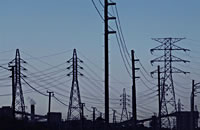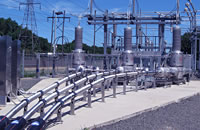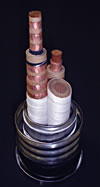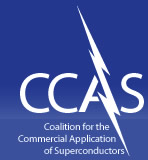Commercial Applications
- Properties, History and Challenges
- Overview
- Electric Power
- Transportation
- Medical Imaging and Diagnostics
- NMR for Medical and Materials Applications
- Industrial Processing
- High Energy Physics
- Wireless Communications
- Instrumentation, Sensors, Standards and Radar
- Large-Scale Computing
- Renewable Energy
- Cryogenics: An Enabling Technology
Applications in Electric Power
Today's power grid operators face complex challenges that threaten their ability to provide reliable service: steady demand growth; aging infrastructure; mounting obstacles to siting new plants and lines; frequent major weather events; threats of terroristic activities and new uncertainties brought on by structural and regulatory reforms. Advances in high temperature superconductivity (HTS) over the past two decades are yielding a new set of technology tools to renew this critical infrastructure, and to enhance the capacity, safety, reliability and efficiency of the nation’s power system.
The U.S. Power Grid Under Stress
 Power industry experts in the United States are widely agreed that today's aging power grid must be strengthened and modernized. Utilities must cope with a growth in the underlying level of demand driven by our expanding, high technology-intensive economy. Consumers in the digital age have rising expectations and requirements for grid reliability and power quality. Competitive reforms have brought about new patterns of power flows. The
frequency and impact of severe weather events such as hurricanes further impacts the grid. It has been estimated that $100 billion could be spent over the next 10 years to achieve and maintain acceptable levels of electric reliability.
Power industry experts in the United States are widely agreed that today's aging power grid must be strengthened and modernized. Utilities must cope with a growth in the underlying level of demand driven by our expanding, high technology-intensive economy. Consumers in the digital age have rising expectations and requirements for grid reliability and power quality. Competitive reforms have brought about new patterns of power flows. The
frequency and impact of severe weather events such as hurricanes further impacts the grid. It has been estimated that $100 billion could be spent over the next 10 years to achieve and maintain acceptable levels of electric reliability.
At the same time, utility shareholders are insisting on strong financial performance and more intensive use of existing utility assets. Moreover, gaining approval to site new infrastructure has become extremely difficult in the face of landowner and community opposition. This is especially the case in urbanized areas where power needs are concentrated and available land is scarce. As a result, utilities face lengthy and uncertain planning horizons, as well as a rising risk of costly blackouts and other reliability problems.
The existing grid is also becoming increasingly regionalized with more generation located remotely to be close to its particular source of fuel. The grid will therefore have to mitigate increasing inter-regional fault current transfers and the increasing number of parallel transmission paths that will be required. Distributed generation can help but is not always available when needed, and also must be redesigned, possibly with the help of fault current limiters, to ride through local faults and remain available.
Solving this complex set of problems will require a combination of new policies and technologies. Regulatory reforms are needed to foster stronger incentives for grid investment and to overcome the fragmentation that has impeded utilities’ ability to raise the required investment capital. Beyond new rules, however, the physical nature of the challenge requires the adoption of advanced grid technologies, including those based on HTS.
 HTS technologies have undergone rapid development in the comparatively short time of two decades since the first HTS compounds were synthesized in research laboratories. Today, the HTS industry has advanced to full-scale power equipment prototypes and demonstration projects that are undergoing the rigors of in-grid evaluation. As these new technologies are incorporated into the existing power system, they will offer utilities new tools to ease the pressures that limit the performance and capacity of their systems - with much lower space and land use impacts than are available using traditional grid upgrade solutions, and yielding major environmental benefits.[1]
HTS technologies have undergone rapid development in the comparatively short time of two decades since the first HTS compounds were synthesized in research laboratories. Today, the HTS industry has advanced to full-scale power equipment prototypes and demonstration projects that are undergoing the rigors of in-grid evaluation. As these new technologies are incorporated into the existing power system, they will offer utilities new tools to ease the pressures that limit the performance and capacity of their systems - with much lower space and land use impacts than are available using traditional grid upgrade solutions, and yielding major environmental benefits.[1]
HTS Wire
 The foundation of these applications is a new kind of wire, capable of carrying vastly (on the order of 100+ times) higher currents than conventional copper wires of the same dimension, with zero or negligible resistive losses. Today’s prototype and demonstration technologies have made use of both first generation (1G) HTS wire that is multifilamentary in composition and, more recently, second generation (2G) HTS wire, using a coated conductor architecture and a variety of thin film manufacturing processes. 2G wire will greatly broaden the addressable market for existing HTS devices because of its predicted lower cost. It will also enable altogether new types of HTS applications due to its superior performance characteristics in certain modes of operation. 2G wire has been commercially available since 2006.
The foundation of these applications is a new kind of wire, capable of carrying vastly (on the order of 100+ times) higher currents than conventional copper wires of the same dimension, with zero or negligible resistive losses. Today’s prototype and demonstration technologies have made use of both first generation (1G) HTS wire that is multifilamentary in composition and, more recently, second generation (2G) HTS wire, using a coated conductor architecture and a variety of thin film manufacturing processes. 2G wire will greatly broaden the addressable market for existing HTS devices because of its predicted lower cost. It will also enable altogether new types of HTS applications due to its superior performance characteristics in certain modes of operation. 2G wire has been commercially available since 2006.
HTS wire, in short, brings the promise of a revolution in the way electricity is generated, delivered and consumed, much as the introduction of optical fiber led to a technological leap forward in the telecommunications industry. HTS wire enables the following power applications.
HTS Power Cables
 Today’s conventional power lines and cables are being operated closer to their thermal or stability limits, and new lines are becoming hard to site. Compact, high-capacity underground HTS cables offer an important new tool for boosting grid capacity and increasing grid reliability and resiliency. Today’s advanced HTS cable designs enable controllable power flows and the complete suppression of stray electromagnetic field HTS power cables transmit 5-10 times more power than conventional copper cables of equivalent cross section, enabling more effective use of limited and costly rights-of-way, and in some cases, also provide fault current limiting.
Today’s conventional power lines and cables are being operated closer to their thermal or stability limits, and new lines are becoming hard to site. Compact, high-capacity underground HTS cables offer an important new tool for boosting grid capacity and increasing grid reliability and resiliency. Today’s advanced HTS cable designs enable controllable power flows and the complete suppression of stray electromagnetic field HTS power cables transmit 5-10 times more power than conventional copper cables of equivalent cross section, enabling more effective use of limited and costly rights-of-way, and in some cases, also provide fault current limiting.
There has been significant progress toward the commercialization of HTS cable. In the U.S., the world’s first HTS power transmission cable system in a commercial power grid is capable of transmitting up to 574 megawatts (MW) of electricity, enough to power 300,000 homes. Close to a dozen U.S. utility companies have either installed demonstration HTS cable projects or undertaken detailed feasibility evaluations. Utility sponsored, in-grid projects are also underway in Germany, Korea, Japan and China
HTS Fault Current Limiters
As new generators are added to the network, many local grids face a rising risk of unacceptably high power surges that result from “faults” or short circuits. These occasional surges are induced by adverse weather, falling tree limbs, traffic accidents, animal interference and other random events. As fault current levels rise, they pose a mounting risk that such surges will exceed the rating of existing conventional circuit breakers, switchgear, bus, distribution transformers, and other equipment, and expose grids to much more costly damage. HTS technology enables a new solution: compact, stand-alone “smart” fault current limiters (FCLs) and fault current limiting capability built into HTS cables which, in both cases, operate passively and automatically as power safety valves to ensure system reliability when individual circuits are disrupted. Taking advantage of the inherent properties of superconductors, they sense such dangerous overcurrents and reduce them to safe levels by changing states instantaneously, from ‘super’ conductors to resistors. Several demonstrations of this breakthrough technology have been completed, with others underway, and commercialization is expected to begin in 2015.
HTS Transformers for the Grid
Grid operators face a major challenge in moving power safely and efficiently, from generators to consumers, through several stages of voltage transformation. At each stage, valuable energy is lost in the form of waste heat. Moreover, while demands are continually rising, space for transformers and substations - especially in dense urban areas - is severely limited. Conventional oil-cooled transformers pose a fire and environmental hazard. Compact, efficient HTS transformers, by contrast, are cooled by safe, abundant and environmentally benign liquid nitrogen. As an additional benefit, these actively-cooled devices will offer the capability of operating in overload, to twice the nameplate rating, without any loss of life to meet occasional utility peak load demands.
HTS Generators for Wind Energy
 The increasing demand for clean, carbon-free electric power, coupled
with the global warming crisis, has fueled tremendous interest in and development of renewable energy technologies such as wind power. To break through the economic barrier and assure the future of this vast and critically important green energy source, new technologies are needed, offering lower weight, higher efficiency and significantly improved reliability. Direct drive wind generators are utilizing a new high-efficiency stator design and replacing copper with HTS wire on the rotor. Estimates are that a 10 MW drive utilizing HTS
technology would weigh about one third the weight of a conventional direct drive generator with the same power rating. This reduction in weight would also allow an increase in blade size and greater power output. The net effect is expected to double the power capacity of conventional systems and lower the cost of wind generated energy.[3]
The increasing demand for clean, carbon-free electric power, coupled
with the global warming crisis, has fueled tremendous interest in and development of renewable energy technologies such as wind power. To break through the economic barrier and assure the future of this vast and critically important green energy source, new technologies are needed, offering lower weight, higher efficiency and significantly improved reliability. Direct drive wind generators are utilizing a new high-efficiency stator design and replacing copper with HTS wire on the rotor. Estimates are that a 10 MW drive utilizing HTS
technology would weigh about one third the weight of a conventional direct drive generator with the same power rating. This reduction in weight would also allow an increase in blade size and greater power output. The net effect is expected to double the power capacity of conventional systems and lower the cost of wind generated energy.[3]
Energy Storage
With power lines increasingly congested and prone to instability, strategic injection of brief bursts of real power can play a crucial role in maintaining grid reliability. Small-scale Superconducting Magnetic Energy Storage (SMES) systems, based on low-temperature superconductors, have been in use for many years. They have been applied to enhance the capacity and reliability of stability-constrained utility grids, as well as to improve reliability and power quality at large industrial user sites with sensitive, high-speed processes. Larger systems and systems employing HTS are a focus of development. Flywheels, based on frictionless superconductor bearings, can transform electric energy into kinetic energy, store the energy in a rotating flywheel and use the rotational kinetic energy to regenerate electricity as needed. Using bulk HTS self-centering bearings allows levitation and rotation in a vacuum, thereby reducing friction losses. Conventional flywheels suffer energy losses of 3-5% per hour, whereas HTS based flywheels operate at <0.1% loss per hour. Large and small demonstration units are in operation and development.
HTS: An Enabler of the Electricity Revolution
The advent of HTS technology offers the opportunity for grid operators to move to a new level of power system performance. Since the dawn of the utility industry in the late 19th century, power networks have been based almost exclusively on components made of conventional materials such as copper, aluminum and iron. The performance and capacity of the grid has been improved and expanded over time, yet grid performance is ultimately limited by the inherent properties and limitations of these materials.
HTS-based technology removes many of these operational and space constraints. It offers grid operators a new set of tools and strategies to improve the performance, reliability, resiliency, safety, land use and environmental characteristics of a power system. The need for such new solutions is becoming acute with the relentless electrification of energy use - a trend that makes our aging, heavily burdened grid more critical than ever to the functioning of modern society.
Issues and Recommendations
In many ways, the electric power industry is at a crossroads. Within the past few years, electric power industry structural reform efforts have stalled perceptibly. The current gridlock in policy reforms and power flows is largely due to the mounting difficulty of expanding the power delivery network. Without a way to expand the “superhighway system” that supports power flows, recent competitive market reforms simply cannot succeed. HTS technology can play an important role in “breaking the gridlock” of power flows and policy reforms that threaten the power industry and our overall economy.
However, before HTS technology solutions can enjoy broad acceptance, they must be proven in multiple demonstrations operating for many years. Such demonstrations play a crucial role in establishing a record of reliability and working out grid integration issues. Despite the acute needs facing the electricity sectors, it is widely observed that investor-owned utilities inherently take a cautious and conservative approach to adopting new technology solutions. This is due to several factors, including: a perception of asymmetric regulatory risks; disallowances resulting from past technology failures and the loss of sites where experimental technologies can be tested without potentially adverse consequences for customers. Industry restructuring efforts underway since the early 1990s, moreover, have had the unfortunate effect of undermining investment in jointly funded industry R&D.
There is an urgent need to reverse this trend. Government bodies - including legislatures, regulatory commissions and research-oriented agencies - can foster a more positive climate for HTS “early adopters.” Comprehensive field trials of these advanced technologies require, by their nature, stable funding on a multi-year basis. There are several specific measures that government bodies can undertake to support the more rapid commercialization of these and other promising grid technologies:
- Encouragement of additional demonstration and pilot projects of advanced grid technologies.
- More favorable rate treatment for grid-related research and development expenditures, which have undergone a steep decline since the early 1990s.
- More thorough review of all feasible alternatives in the regional planning process, including low-impact grid upgrades along with other conventional and non-conventional solutions.
- Review of the criteria governing the use of “clean energy funds” and other state mechanisms to promote new technology development and deployment. For many emerging technologies, the “missing link” to market acceptance is a reliable pathway to market that could be provided or enhanced by innovative grid technologies enabled by HTS.
- [1] 138kV HTS cable system installed in Long Island, NY. Image courtesy of American Superconductor.
- [2] HTS power cable. Image courtesy of Sumitomo Electric / Superpower.
- [3] Wind turbine. Image courtesy of American Superconductor.

